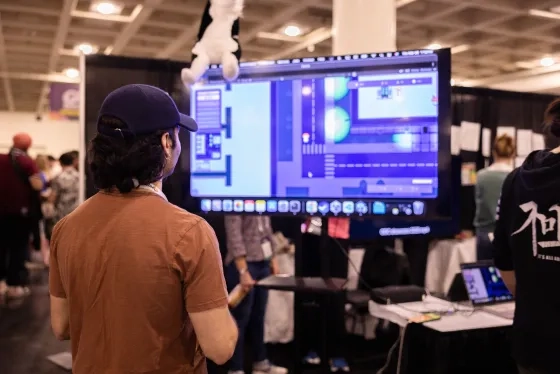Press Start: New Creative Collaboration Has Students Scoring Games from Scratch
Students were given the opportunity to score games from the ground up with peers studying game design at Mills College at Northeastern University.
SFCM students in the Technology and Applied Composition (TAC) Department recently got to see a months-long collaboration come to fruition at the Game Developers Conference (GDC) held in San Francisco in March.
In a landmark collaboration with Mills College at Northeastern University, TAC students were partnered with Mills students learning game design and tasked with creating a score to the nascent games, which were then demoed at GDC and, in April, a Game Design Co-Lab event at Northeastern/Mills.
"This collaboration started when I found out that Northeastern University in Boston had taken over the Mills college campus and started an extension of their game design degree,” TAC Executive Director Steve Horowitz says. “Since they’re local, it made sense to try and hook their game designers up directly with our audio teams to help with music, sound design, voiceover and audio implementation.”
Horowitz says that the collaboration felt like a win-win situation from the start. “Mills professors and I were perfectly aligned as to the value this collaboration would bring to all of our students. Their game designers would get a chance to use our amazing facilities and get super high-quality audio for their games and our audio folks would get a chance to get more deeply involved with the game design process.”
SFCM student Ian Kaneko had some familiarity with the game design process, but says “This was a really exciting chance for me to bring that into school and just to do what I want to do outside of school anyway.” He continued, “The Mills students came here and presented their ideas for games down in Studio G. They pitched two games and those ended up being the ones that we actually followed through with the whole time.”
Student Manuel Calderon was thrown a creative curveball when he was asked to compose in 8-bit music, a throwback to the earliest cartridge video games whose limited memory meant equally limited sounds (Think the Super Mario Bros. theme.) “I grew up composing with all this technology and applying great plugins,” he says, “so to me 8-bit sounds super-exposed. You have to control the synthesizers and all the parameters of the 8-bit sound in order to make it sound good. This was my first time with it, so that was the challenge for me to face.”
Calderon went into more detail about what composing for games actually entails. “The composer works with an implementer, who is sort of the middle-man between the music and the gameplay. We have to encode all the audio into the structure of the game engine, and kind of program all the ways in which it’ll work along certain actions or scenes in the game. Different music might be triggered by the character moving into a new area, or by them sleeping or resting.”
Working with game designers as a composer or sound artist, Calderon says, in many cases means anticipating the needs of the game before the designers do. “They're thinking first about creating the graphics and designing the game,” he says. “They’re not sound people. So it was nice to be challenged from the perspective of an audio producer, and saying, ‘Well, we’re going to need this and this.’ For example, they were just thinking of having the same footstep sound everywhere in the game, as opposed to different ones for the different surfaces the character is walking on. Those are the small details that really make the experience better for the player.”
In March, the fully scored games were available for GDC attendees to play, with designers, sound artists, and composers all able to see how their final product landed in real time. “I think it came out really well,” Kaneko says. “It's always a really fun experience when you actually hear all the sound design and music come together at once, because composing you just hear everything on its own and not as part of the full game experience.”
Horowitz adds that this collaboration is important to the overall structure of the TAC game design track, which he calls “one of the most—if not the most—complete game audio design tracks in the world.”
“Students go from Intro to Sound for Games into two sections of music scoring with luminaries like Lennie Moore and Matt Levine, then they get a full year of working with middleware with Scott Looney from The Game Audio Institute. The last thing they do is work on advanced system design and participate in these collaborative teams. Frankly, by that time they are more than ready to tackle all the creative and technical challenges that come along with game audio design.”
Learn more about studying Technology and Applied Composition at SFCM.



